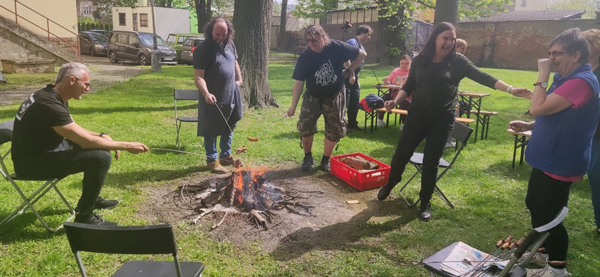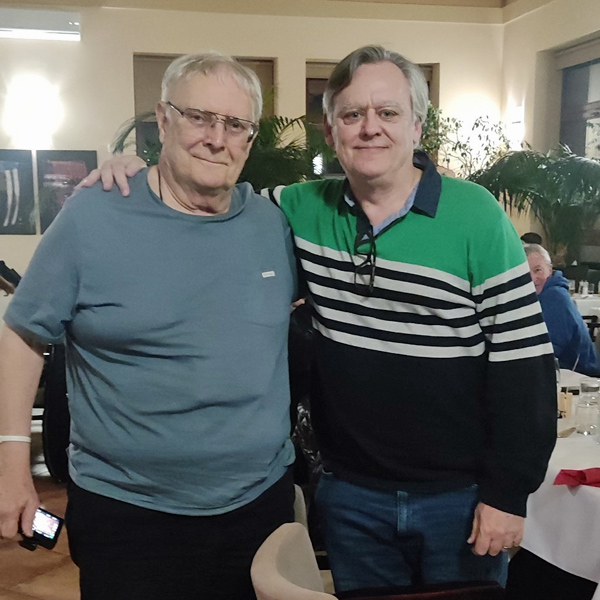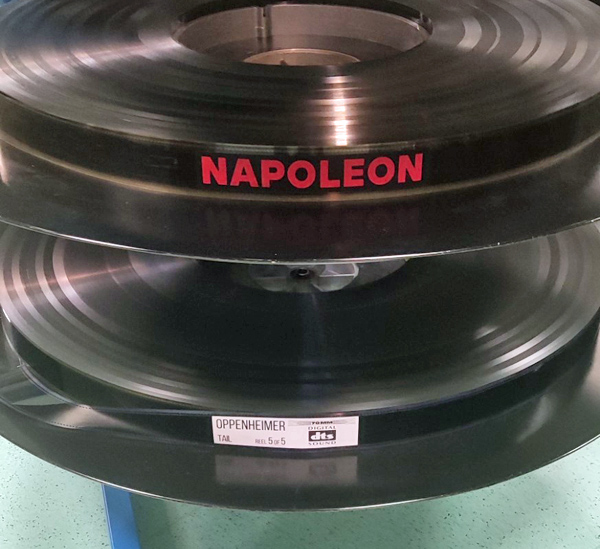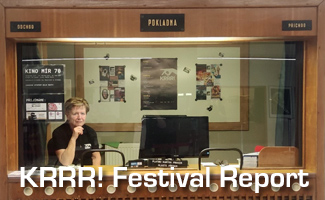|
| |
Festival Report 17th KRRR!
12 - 14 April 2024, Kino Mir 70, Krnov, The Czech Republic |
Read more at
in70mm.com
The 70mm Newsletter
|
|
Written by: Ramon Lamarca, Reel Solutions, UK |
Date: 23.04.2024 |
 This
was my first visit to the Krrr! Festival in the city of Krnov (Czech
Republic). I arrived on Wednesday evening due to flight availability
from London to Ostrava and also to have the opportunity to find out more
about their amazing subtitling system and technical setup on Thursday,
whilst they were completing their last tests and preparations for the
festival. I had been communicating by email with a member of the
Festival team, Mr Ivan Školuda, about their system to synchronise
subtitles and audio to 70mm prints and I was looking forward to seeing
it in action. This
was my first visit to the Krrr! Festival in the city of Krnov (Czech
Republic). I arrived on Wednesday evening due to flight availability
from London to Ostrava and also to have the opportunity to find out more
about their amazing subtitling system and technical setup on Thursday,
whilst they were completing their last tests and preparations for the
festival. I had been communicating by email with a member of the
Festival team, Mr Ivan Školuda, about their system to synchronise
subtitles and audio to 70mm prints and I was looking forward to seeing
it in action.
I had not been to the Czech Republic since their socialist days and that
was a long time ago, it was nice to be back. I spent most of the time
in the cinema but what little I saw of Krnov and the surroundings gives
me even more reasons to come back with more time to see them when I
return next year. The Kino Mir 70 cinema is really impressive, a large
building with an spacious hall and majestic stairs that take you to the
auditorium. The entry hall had many Czech projectors (both 35 and 70mm) on
display and they also had functioning 16mm projectors, which would be
used for some demonstrations during the festival. The projection room
has two Czech Meopta UM 70/35mm projectors, one 4K digital projector
and one 35mm projector. There are many rewind machines, a vintage slide
projector (in full working order) and a metal cabinet for the film
reels. The auditorium is very nice with green colour instead of the
standard red, which I think is an original touch. It has Dolby Atmos and
the 5-speaker configuration behind the screen. Seats are
comfortable and with plenty of leg room. Entrance is from the back of
the auditorium.
On Thursday I had the opportunity to see the test of the 70mm print of
"Top Gun", an almost pristine print with very good colours but with
Spanish dubbing. The geniuses at the Krrr! Festival managed to
synchronise to perfection this print with the digital English audio of
“Top Gun”. I was really impressed. I was also truly blown away by the
steadiness of the projectors, rock solid and no perceptible light
flickering, really good quality. The screen is slightly curved and with
very comprehensive masking for all ratios. The 70mm screen ratio is 1:2.20,
as it should be! We stopped briefly for lunch and they invited me to a
traditional Czech barbecue in the garden outside the cinema building but
within its premises. Before I continue, I want to emphasize the
hospitality of the organisers, I felt really welcomed and looked after,
and I am extremely grateful to them. We continued the afternoon with the
second half of "Top Gun" and tests of
"My Fair Lady". I was then invited for
dinner and enjoyed the dishes they recommended to me as traditional of
the Czech Republic. The dinner brought an added surprise, the arrival of
Paul Rayton and his wife. I had not seen them for a while and didn’t
know they were attending the festival. We then went to the cinema for an
additional test of some fragments of 70mm to be shown on Sunday.
|
More
in 70mm reading:
• 17th 70mm Film Seminar, KRRR!
• Home of "7OMM Seminar" at Kino Mir 70, Krnov, Czech
Republic
7OMM Seminar Through the Years:
• Film Program
• Text and Image
About Todd-AO
• Počátky
Todd-AO
Internet
Kino Mir 70
Namesti Miru 14
794 01 Krnov
The Czech
Republic
Telephone: +420 554 615 050
• Festival Page
•
KRRR! Facebook
|
 Barbecue
in the cinema garden Barbecue
in the cinema garden
Throughout my visit, Ivan
Školuda (projection, programming and prints
location), Michal Jaso (Cinema Mir 70 director), Michal Mráz
(programming and prints location), Martin Leskovský (projection) looked
after me and responded to all my many questions, always with a smile.
Friday started with one of the highlights of the Festival, being able to
leave my raincoat in their cloakroom! A cinema with a cloakroom. How
cool is that? There aren’t cinemas with cloakrooms anymore, this is real
showmanship. The hall also had an old-style box office and confectionary
shop. This vintage environment transports the visitor into the past, into
the glory days of cinema and it is part of the great experience. All the
introductions are in Czech (obviously) but with simultaneous translation
through wireless headphones. The first film on Friday was "Ulzana", an
East German DEFA coproduction with the Soviet Union and Romania. It was
a Russian blow-up print dubbed into Russian and in mono but it was
presented with synchronised Czech mono audio sound and English
subtitles. This was an Orwo colour print, somewhat faded and probably on
its last legs. It was a curious experience into the history of cinema, watching an original Russian blow-up print
with the story being a communist western. There
was a huge contrast between the quality of this print and the amazing
quality of the next one,
"Oppenheimer", which I had already seen in
15/70mm. I have to say that, although I really liked the full IMAX ratio
sequences, the consistency of aspect ratio (1:2.20) throughout the film
is extremely pleasant and provides a different experience. The print is
in amazing, pristine condition but, as Ivan and other projectionists
pointed out, it actually does not have the sharpness of the original print of My
Fair Lady we were about to see, and they were absolutely right.
|
|
 Paul
Rayton and Ramon Lamarca Paul
Rayton and Ramon Lamarca
It is difficult to tire of seeing "My Fair Lady", such an enchanting and
charming film. It is a pity that there is no full print of the
1994
restoration
which is available to be screened, and so the team at Krrr! managed to locate an original Czech distribution print, which was
incomplete and with different degrees of quality between the reels. What
followed is the best example of showmanship I have ever seen. The
incomplete sequences were provided by a digital file, which had its
colour modified to match the faded tones of the film print. Moreover,
sections of the film print that could not be focused, were scanned frame
by frame and projected digitally. Hats off to this massive effort to
present "My Fair Lady" in 70mm and beautiful six-mag tracks.
Saturday required an early start to see
“The Aeronauts” in 70mm, something
I was really looking forward to. I had seen it in digital IMAX and was
very curious to see how it would look in 70mm. In digital, everything
shot on the ground is in 2.39:1, and then when they go up into the air,
it opens up to 1.85:1 Imax [1,43:1, ed]]. There was a significant jump in quality (and
also a bit in ratio) in digital IMAX, which was an artistic decision but
I much more enjoyed the constant aspect ratio throughout and the
smoother transition between resolutions on this 70mm print. The film is
designed for the big screen and the vertigo inducing sequences in the
air (brilliantly shot) can only be truly experienced on a big screen,
like we did here at the KRRR! Festival.
This screening was followed by two lectures. The first one was given by
Radomír D. Kokeš, from the Department of Film Studies of the Masaryk
University. It has a very interesting, comprehensive and reasoned
analysis of the duration of films throughout cinema history. His talking
was quite fast and, at some points, it was challenging for the translator
to follow him. This presentation was followed by a lecture on 70mm
projection by Ivan Školuda, which gave us a very good insight on all the
amount of work that goes behind the scenes before and during the KRRR!
Festival. He had explanations for the quality, characteristics and the
challenges of each print presented in the festival. It is just short of
amazing what the team does to bring all these films to big screen.
|
|
 Napoleon
and Oppenheimer on the platter Napoleon
and Oppenheimer on the platter
The presentations were followed by
“Close Encounters of the Third Kind”. I
have seen the film on several occasions, even with live orchestra but I
don’t remember ever seeing it in 70mm. The print has some scratches and
some fading but it was good to feel all the sound dynamics that magnetic
sound can provide. After "Encounters" we had the introduction for
"A Bridge
Too Far", which was the first of several deprecating presentations,
highlighting the lack of artistic merits of the films. Roger Ebert's
original, scathing review of the film was mentioned, which is quite
dismissive of the film. I was expecting a pink film and I was surprised
to see that there is still a significant color palette and with superb
magnetic sound. The print came from the BFI and so it is in good shape,
taking into account its age. Although it does not suffer from vinegar
syndrome, it suffers from something also similarly damaging to the eyes,
the abuse of fog filters!!! The use of these filters to soften the
images was quite common in the 70s and Geoffrey Unsworth (director of
photography) was one of the main culprits and the resulting glow of the
bright areas of the image because of the filters can be really annoying.
Otherwise, the battle scenes, in particular the impressive parachuting
sequences, are well filmed and the muted ending carries the anti-war
message.
At this point I was feeling I bit tired but I could not miss
"Napoleon",
even at its 158 minutes. The 70mm print is in pristine condition but the
film looks too digital and even a film print cannot mask this. The rock
steady quality of the Czech projectors (and the projectionists!) made
this print look very close to what the digital presentation of the film
must have been, although adding some of the softness and warmth film
provides. The battle scenes are quite impressive but the rest is
basically ‘Carry On Josephine’. By the way, my criticism of the film
pales in comparison to the very deriding introduction of it provided at
the festival, which mocked Scott’s efforts in portraying the French
emperor. I don’t think I had ever been so long at any cinema, from 09:30
hours in the morning to 24:00 hours. But it was worth the effort!
On Sunday I skipped "Top Gun" at 09:30. I had already seen it during the
test screening and couldn’t really wake up so early after the previous
very long day. As I said previously, this is a very good print and the synch
of the English sound by mechanical and digital means is truly amazing
and a credit of all the good work of the festival.
|
|
 Staff
at delegates desk Staff
at delegates desk
I arrived for the 70mm fragments selections, which included a reel of
Poltergeist, a reel of
“The Empire Strikes Back” another of
“Becket”,
followed by "Grand Prix" (its 65mm origination was obvious when compared
to the others) and
"The Sound of Music" (also extremely sharp, albeit faded).
I understand that there was a plan as well to show a reel of
“Camelot”
but this was not possible due to time constraints.
“Solomon and Sheba”,
shot in
Technirama, was the next film and it had another harsh
introduction positioning the film as one of the worst epic ever made and
wishing us a good nap. We were also told about the difficulties of
screening the print, with some reels suffering terribly from vinegar
syndrome, which had to be scanned to manage some focus. The film was
really in very bad shape and pink throughout with very few exceptions,
like Lollobrigida’s green parrot. The hand of King Vidor is noticeable
in the appropriate management of large-scale sequences and although the
orgy scene is rather embarrassing it betrays Vidor’s origins in silent
cinema. The famous Solomon sequence of the baby claimed by two women as
theirs had to be skipped due to technical problems, although I was lucky
enough to see it during the testing of the film.
The festival finished on an extremely high note,
"Joker" in 70mm. Although
the film is shot digitally, a lot of care has been taken into recreating
a film look. On this 70mm print, it felt very much as it had been shot
in analogue, with saturated colors and deep blacks. The film is rather
disturbing and the quality of the print accentuated its powerful effect
on the viewer. Needless to say, the print is in pristine condition.
That was it for this year, an amazing experience overall firstly from a
technical point of view, but above all from a human perspective. As I
said, the hospitality of the team is second to none and I look forward
to returning to Krnov next year to see more amazing presentations and
talk to the team again.
|
|
|
|
|

• Go to Festival Report 17th KRRR! |
|
Go: back - top
-
back issues - news index
Updated
22-01-2025 |
|
|
|